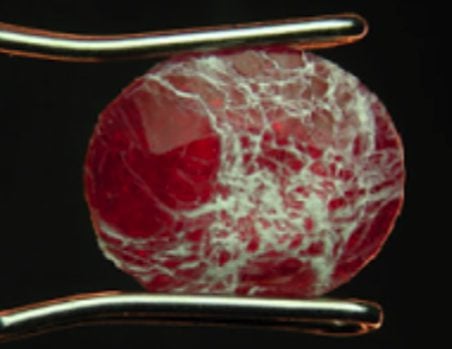Ruby-Glass Composites vs Leaded Glass Clarity Enhancements
Ruby-glass composites and leaded glass ruby clarity enhancements are difficult for gemologists to detect. Learn how to identify these gems and procedures.
6 Minute Read
Ruby-Glass Composites or Leaded Glass Treated Rubies?
During a meeting of the Laboratory Manual Harmonization Committee (LMHC) in 2007, Dr. Pornsawat Wathanakul (Scientific Advisor to the GIT member) reopened discussions on glass fracture filling in ruby. Several members had noted myriads of large gas bubbles within the newer material submitted to their laboratories. In many cases, they found the glass filled wide seams crossing facets and accounted for an ever-increasing volume of the finished product. Furthermore, members surmised from observation that the glass held the material together. In other words, the glass acted like an adhesive.
Following discussions, the LMHC agreed this treatment went beyond any “fracture filling or clarity enhancement” process. The group decided to describe this (heavily treated) material as “ruby-glass composite” on all future identification reports.
Ruby Vocabulary Revisions
The Jewelers Vigilance Committee (JVC), along with other trade organizations, submitted a brief to the Federal Trade Commission (FTC). They suggested a number of vocabulary revisions to its Guides to ensure a standard throughout the industry, such as the following:
- “Natural” should refer to untreated rubies.
- “Treated” should identify rubies treated with traditional methods, such as heating to modify color or healing open fissures by adding chemicals, which
…
Jeffery Bergman, SSEF SGC
Jeffery Bergman, SSEF SGC, founder and director of 8th Dimension Gems in Thailand, is an American gem dealer with more than 40 years of experience in gemstone and fine jewelry mining, cutting, wholesaling and retailing. His career has taken him to more than 50 countries and every continent except Antarctica. He has appeared on the BBC, CNN, NBC, ABC and GEO; and has been featured in Time, USA Today, National Geographic, Gems & Gemology and Discovery Channel magazine. He is a regular guest speaker at gem lab seminars and gemological association conferences and universities.
Related Articles
Ruby Gemstone Value, Price & Jewelry Insights
Corundum Value, Price, and Jewelry Information
How to Identify Ruby Simulants and Synthetics
Ruby Buying Guide
Latest Articles
Opal Buying Guide
Amethyst Sources Around the World: The Geological Story Behind These Purple Gemstones
Brazilianite Value, Price, and Jewelry Information
Ruby-Glass Composites vs Leaded Glass Clarity Enhancements
Never Stop Learning
When you join the IGS community, you get trusted diamond & gemstone information when you need it.
Get Gemology Insights
Get started with the International Gem Society’s free guide to gemstone identification. Join our weekly newsletter & get a free copy of the Gem ID Checklist!
